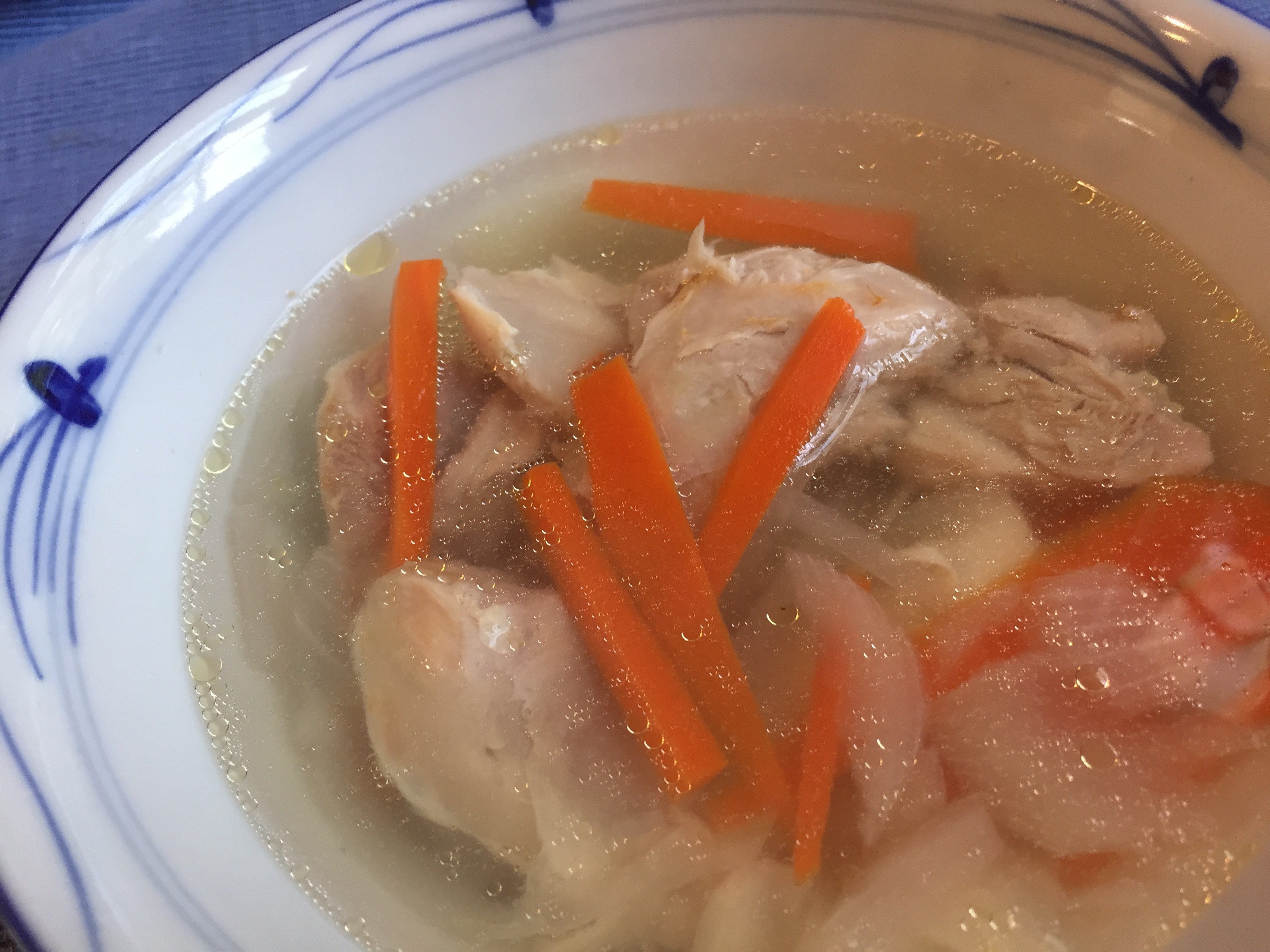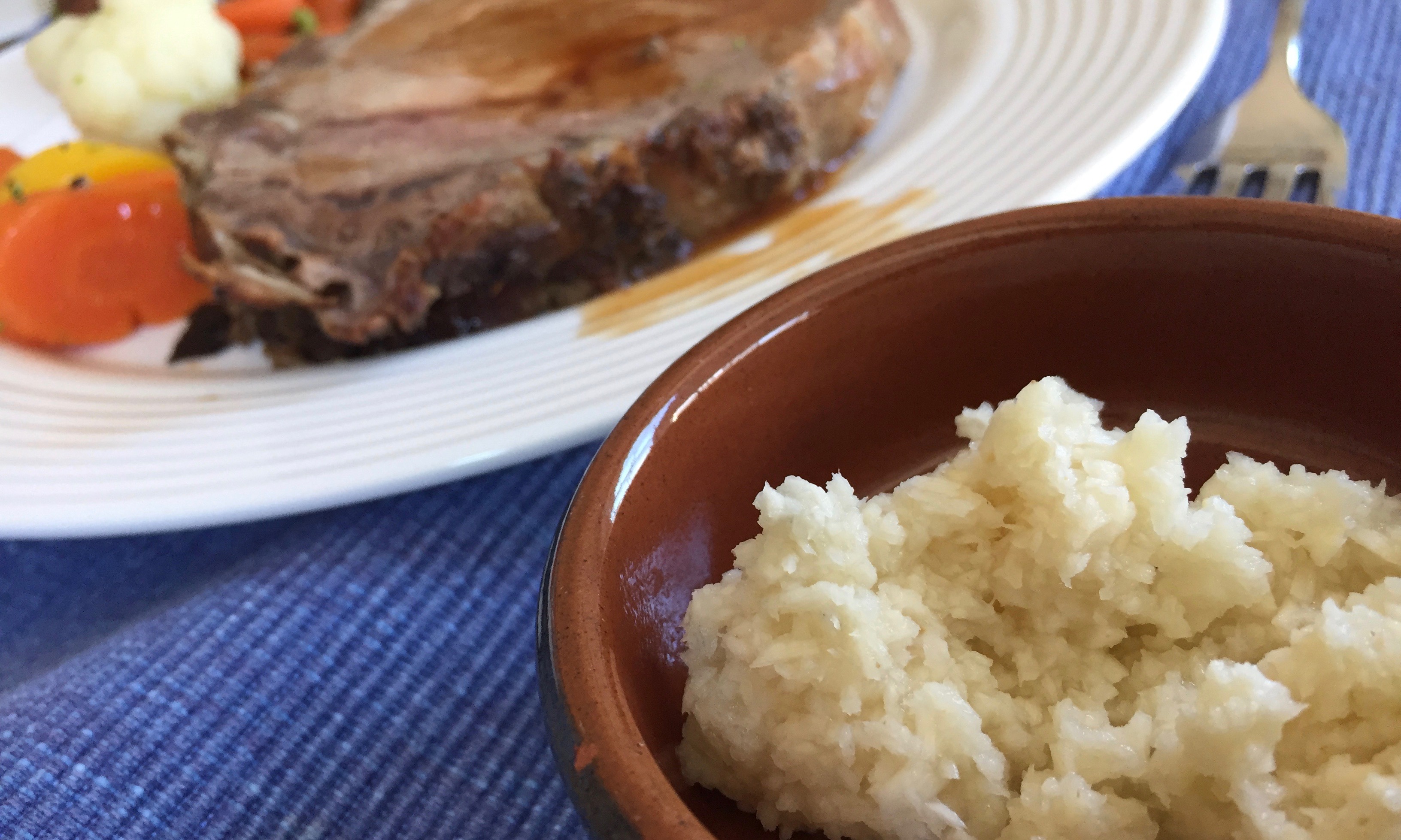Well, I’m back. After a brief hiatus over the summer when I traveled from Maine to Singapore and took care of house renovations I have returned.
Summer has been busy–isn’t that so for all of us? I feel I need a holiday from it especially after I caught a cold from my cute little grandson. He had a snotty nose which we kept wiping. Even from a baby, those germs can spread. Both my son and I ended up with a cold, and realized that poor baby had to sit in the sun through a formal army affair feeling so wretched.
When I was feeling bad–whenever I feel stuffed up–all I really want is something soupy. Like pho or Singaporean fishball noodles. But the proverbial cure-all is chicken soup.
Chicken soup really does wonders for me. So I’m starting this year’s posts with Chicken Soup because it’s something great for fall and winter as well. I’m going to offer variations of how we make and serve chicken soup in our family because Cantonese cooks are well known for their soup.
We typically have soup every day. At least in the ole days we did. We don’t necessarily make large pots of soup. Sometimes we make soup even for two people. Home cooks make their soup mid afternoon and leave it to simmer and have it ready before dinner. We also didn’t drink water with dinner.
Technique for cooking, whether it is with pork, chicken, duck, or beef, is the same.
Here in Fairfax, when I’m drained (no pun intended) by a cold, my go-to is to get a whole, small chicken from the Asian supermarket. The smaller 3-pound chickens are not as expensive; that size is all I need. A large roasting 5-pound chicken would take so much space in my pot and give me chunky tough breast meat after extended simmering. In Chinese markets they sometimes sell aged or black chicken. These look scrawny and aged but makes very good and supposedly healthful chicken soup.
Here are some photos of chickens Chinese like to use in soups. They look, uh, unappetizing. On the left is an aged chicken, sold under the label “Old Chicken Hen.” This scrawny one looks a little more palatable than the second, labelled “Fresh Black Chicken.” Maybe I’ll try cooking it some day to see if I taste a difference. I’ve eaten it but never cooked one.
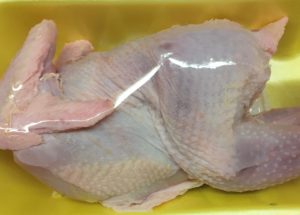

Our neighborhood supermarkets usually sell only roasting chicken. So for this recipe I used a packet of drumsticks. Six legs for less than $3. Not bad. What I was looking for is bone to make a good stock. Thigh with bone in doesn’t give enough bone. Sometimes I find drumsticks chopped through the bone in Asian supermarkets. This makes great stock because the bone is exposed but then you risk having splintered pieces of bone mixed with tender vegetables and chicken you want to nosh on.
Bone is what makes the stock tasty. In Asia’s wet markets sometimes you’ll find vendors that sell backbones of chicken that have been deboned. Those make the best chicken soup stock. Mum and my sister Bette love chicken feet and you can get a bag of chicken feet for a couple of dollars. These bones make the stock really tasty. My family isn’t crazy about finding chicken feet in their soup so drumsticks it will have to be.
In some recipes for chicken soup I find it funny one ingredient is packaged chicken stock. I do that sometimes when making a quick vegetable soup of some kind but when I’m doing the heal-the-cold homemade chicken stock, it’s got to the fresh chicken. Must be my Cantonese influence. Even frozen chicken won’t cut it.
Leftover carcass from rotisserie chicken also makes great soup. My favorite lazy dinner is rotisserie chicken from Costco for $4.99 or something. I debone the breast, thigh and drumstick, leaving a generous portion of meat stuck to the bone and I make that into soup, adding the delicious drippings into the pot. It has a different flavor than fresh chicken, but also tasty. That one chicken can make me more than three meals. Chicken, cold chicken, chicken soup, chicken with rice vermicelli. For less than $5!
The basics – what goes inside chicken soup
Aromatics: Got to add aromatics. When making soup today I used my favorite combo of onion and carrot. If I’m eating it like a western soup I’d also add celery. If I want a truly Cantonese flavor I’d add ginger and onion. Two or three slices of ginger is plenty.

Chicken: Add whole, half or just the bones. With whole chicken you could leave the skin in or not. I usually skin it and also remove most of the fat. Also I sometimes split the chicken in half separating the breast side from the back. This exposes the bone for more flavor. But I’ve also just left the chicken whole.
When using drumsticks, I cut slits into the meat to expose the bone for more flavor.
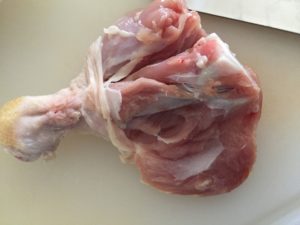
Water: To make soup from one chicken or drumsticks I usually use a 5 quart pot. Put the chicken and aromatics in and then fill it with water up to about 1½ to 2 inches from the rim of pot. If you want a richer stock then use less water.
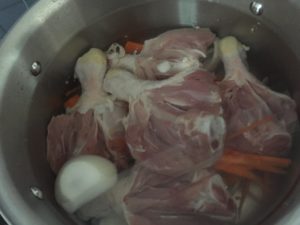
Boiling technique: Bring water to a boil. As soon as it boils, lower to simmer and let it cook covered for 45 minutes to an hour.
To cover or not: That’s debatable. I have an Ikea pot, my favorite soup pot, that has a tiny steam vent on its lid and when I cook soup covered, the soup simmers perfectly–a gentle rolling boil where the bubbles don’t break the water. I just leave it for 45 minutes to 1 hour and the soup is perfect.
Ironically, when I use my All-Clad supposedly better (i.e. more expensive) pot, the simmer gets really fussy. This one has no vent. When I lower the simmer to try to maintain a gentle rolling boil, it sometimes stops simmering altogether. Or it boils over. I’m wasting time watching the water bring to a simmer. You know what they say about a watched pot. It’s very annoying. My solution to using such a fussy pot is to leave the cover slightly open. See below. Crazy huh? That maintains the temperature but doesn’t dry out the soup too much. I remember the cooks in our home doing this decades ago.
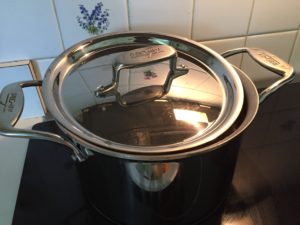
How does the professional do it? I’ve noticed that my chef friend Todd simmers soup (in one of those humongous pots) with the lid off.
So there you have it. Your choice. Simmer uncovered, simmer covered, or simmer half-covered. The thing is to keep it at a simmer over time and it will taste delicious.
What to do with scum? If the chicken is chilled, you may have scum floating at the top during the rigorous boiling. You could scoop it up with a fine mesh ladle but if you left the scum and not let it gross you out, it will form into brownish floatties later. We used to eat them as kids but being more delicado now I just scoop it away.

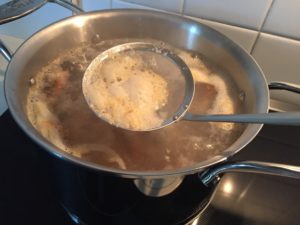
How long? That depends on whether you want to eat the meat or not. In Cantonese cuisine, soup is perfectly cooked when the meat is super tender, and the meat is still intact with bone. This is because we love eating the meat in soup. If the meat has been cooked until it has separated from the bone and the chicken is in small pieces, the soup is overcooked. You’re fired.
In my kitchen if the stock is all I want, then it doesn’t matter how over cooked the chicken is.
For Cantonese style soup, I usually simmer my soup for about 45-60 minutes. Chicken may be dipped in soy sauce and red chili or soy sauce with white pepper, my mother’s favorite.
For a rich stock simmer for another 30 minutes and drain and discard chicken, bone and aromatics. Stock may be used in frying, braising and a soup base for another soup. You can also freeze it in small portions for later use.
What to add to basic soup: After I have made the basic broth, I add vegetables to make the soup I want. This is added just before serving and simmered for less than 2 minutes so the vegetables are not overcooked.
Popular Cantonese soups are made with watercress, different varieties of Chinese spinach, Napa cabbage, cabbage, lotus root. The different vegetables turn the soup into a completely different soup! And we have dozens of different Chinese leafy vegetables, many of which are found only in Asian supermarkets. See below recipe for variations.
In the picture below I added sweet corn to my soup, making my soup a little western. The next day I added watercress, which is a popular home-made Cantonese soup. Try it with any leafy vegetable–kale, mustard green, cabbage. Even zucchini, mung bean sprout, and lotus root.
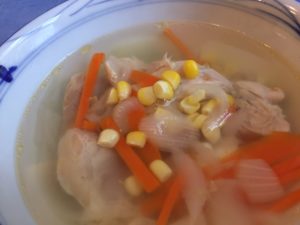
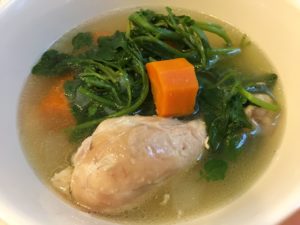
Basic Chicken Soup
Serves 4-6
Preparation time: 10 minutes
Cooking time: 45-60 minutes
6 drumsticks
8 ounces onion, roughly chopped
6 ounces carrot, cut in large chunks
2½ quarts water
2 bunches watercress
Salt
Slit meat of drumstick to expose bone.
Put chicken, onion and carrot in a 4 or 5-quart pot. Fill water until it reaches about 1-2 inches below brim of pot, about 2½ quarts. Bring water to a boil. Scoop up foamy bits and discard. Watch pot at start of cooking as water may boil over. Once it starts to boil, reduce heat to a simmer. The water should have movement but not break into bubbles.
Cover pot with lid and continue simmering for 45-60 minutes. Check occasionally to make sure that the stock is not brought to a rolling boil, or have stopped boiling completely! Add salt to taste, about 3-5 teaspoons.
Add watercress and simmer until water is just tender, about 2 minutes. Add salt to taste.
VARIATIONS
Tweak the ingredients to change the flavor of this basic soup.
Different meat:
–Instead of drumstick, use a whole chicken.
–Consider using black chicken, which is Silkie chicken, sold in Asian supermarkets, for a different taste in stock.
–Carcass from rotisserie chicken.
–Leftover roast turkey bones.
–Pork bones.
Nowadays I use chicken in my soup but my favorite stock is made with pork ribs. Meat off pork rib is so delicious when perfectly cooked. Just replace chicken with 2 pounds of pork ribs. Ribs that have a lot of meat–loin ribs, or baby back ribs–work and taste best.
–Pork neck bones or leg bones give really good flavor when cooking pork soup only for stock. I still enjoy sucking meat off these bones.
Different vegetables:
Cooking it with a different vegetable really changes the flavor of the soup
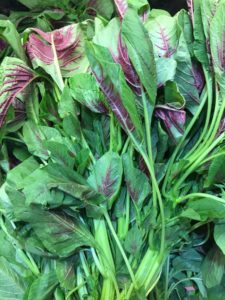 Add any of these vegetables:
Add any of these vegetables:
–1 potato, cubed, and 1 small tomato sliced.
–3 ears of corn, each cut into four pieces.
–8-12 ounces (250-350 grams) cabbage, cut in strips.
–2 or 3 cups of spinach.
–2 or 3 cups of Napa cabbage.
–3 cups amaranth or Chinese spinach. Photo of amaranth shown on left.
Different aromatics:
–Add garlic and ginger.
–Roots of cilantro.
–Tianjin preserved vegetables, rinsed. Add during or after cooking. If it is to be simmered, add ½ tablespoon. As a garnish, chop it and add sparingly, a few pinches per serving. For photo of these preserved vegetables click here.
Chinese traditional dried foods:
–4 or 5 Chinese dates.
–5 dried small Chinese mushrooms: soaked till soften. Add new ingredients after soup has simmered for 30 minutes.
–Dried scallop: toss in 3 or 4 pieces of dried scallop for a richer flavor.
–Chinese almonds.
